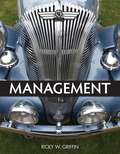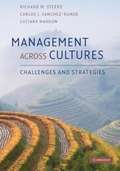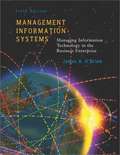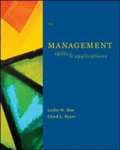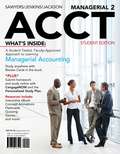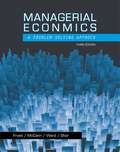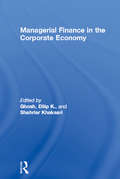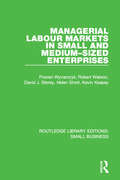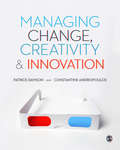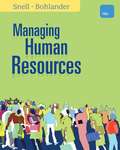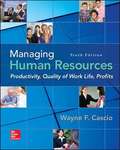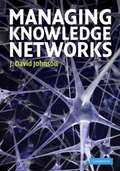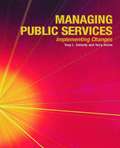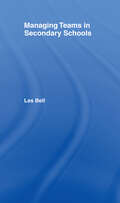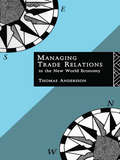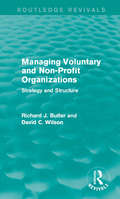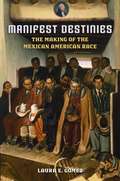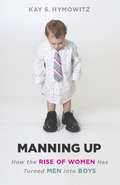- Table View
- List View
Management (11th Edition)
by Ricky W. GriffinThis book takes a functional approach to the process of management with a focus on active planning, leading, organizing and controlling.
Management Across Cultures: Challenges and Strategies
by Richard M. Steers Carlos J. Sanchez-Runde Luciara NardonManagement practices and processes frequently differ across national and regional boundaries. What may be acceptable managerial behaviour in one culture may be counterproductive or even unacceptable in another. As managers increasingly find themselves working across cultures, the need to understand these differences has become increasingly important. This book examines why these differences exist and how global managers can develop strategies and tactics to deal with them. Key features: - Draws on recent research in anthropology, psychology, and management, to explain the cultural and psychological underpinnings that shape managerial attitudes and behaviours - Introduces a learning model to guide in the intellectual and practical development of managers seeking enhanced global expertise - Offers user-friendly conceptual models to guide understanding and exploration of topics - Summarizes and integrates the lessons learned in each chapter in applications-oriented 'Manager's Notebooks' - A companion website featuring course outlines, slides, and case studies is available at www. cambridge. org/management_across_cultures.
Management Information Systems: Managing Information Technology in the Business Enterprise (6th edition)
by James A. O'BrienThis book will be very much useful for business students who must be conversant with the tools of MIS to become successful managers and entrepreneurs. Students learn how Information Technology provides them with a powerful managerial resource that can help manage business operations, make better decisions, and gain competitive advantages.
Management: Skills and Applications (13th Edition)
by Leslie W. Rue Lloyd L. ByarsManagement: Skills and Application, 13e by Rue and Byars is a short, value-priced paperback that presents the fundamentals of management principles to undergraduate students. It continues its tradition of presenting principles of management in a straightforward and accessible manner, focusing on the essential skills that are needed to become a successful manager.
Management: Top Secrets Of Highly Effective People On How To Acquire Habits To Increase Your Self-discipline And Poor Time Management (Brian Tracy Success Library)
by Brian TracyUnlock the secrets to turning even ordinary employees into extraordinary performers!Do you want to become invaluable to your company? The unparalleled key to achieving that notoriety is to learn how to boost your managerial skills and bring out the best in your people.If that sounds simple, that&’s because it is! Great managers are made, not born. Renowned success expert Brian Tracy has written Management, a handy, easy-to-follow guide to help you improve yourself as a manager and a professional in general.In Management, Tracy shows how anyone can easily:Set performance standardsDelegate productivelyDefine key result areasConcentrate attention and resources on high-payoff activitiesHire and fire effectivelyBuild a staff of peak performersHold meetings that workCommunicate with clarityNegotiate successfullyRemove obstacles to performance, and more!Filled with practical, proven techniques and tools, Management is an essential guide that shows you how to bring out the best in your people--and be seen as an indispensable linchpin by the leaders of your organization.
Manager 3.0: A Millennial's Guide to Rewriting the Rules of Management
by Brad Karsh Courtney TemplinMillennials mean business, and they are shaking up the workplace as they enter management roles for the very first time. They are tearing down the corporate ladder, communicating on the fly, and bringing play to work. Millennials are creative, big thinkers, and they will change the face of leadership--IF they can bridge the gap between the hierarchical management style of senior executives and the casual, more collaborative approach of their peers. Manager 3.0 is the first-ever management guide for Millennials. They will master crucial skills such as dealing with difficult people, delivering constructive feedback, and making tough decisions--while gaining insight into the four generations in the workplace and how they can successfully bring out the best in each. Packed with interviews and examples from companies like Zappos, Groupon, Southwest Airlines, and Google, Manager 3.0 will help these new managers enhance their unique talents while developing an effective leadership style all their own.
Managerial ACCT2
by Steve Jackson Roby Sawyers Greg JenkinsDesigned for and by today's students in every detail, Financial ACCT2 was developed from nearly 300 students and 100 faculty members to provide a more engaging and accessible solution that appeals to different learning styles at a value-based price. ACCT2 includes all of the key concepts that your instructors require and a full suite of learning aids to accommodate your busy lifestyle including chapter-by-chapter study cards, self-quizzes, downloadable flash cards, animations, and more. ACCT2 employs an engaging narrative that emphasizes strong and effective examples to convey and reinforce fundamental financial accounting concepts and procedures. In an attempt to avoid excessive detail, the book focuses on the core concepts that students need to learn in the course through the use of streamlined chapter objectives, shorter chapters, clarity of examples, and a visually engaging design. Included with each new copy of the text is access to Cengage NOW, where many of these rich media assets are housed and you have a multitude of opportunities to practice accounting.
Managerial Accounting
by Joe Hoyle Kurt HeisingerKurt Heisinger and Joe Ben Hoyle believe that students want to learn accounting in the most efficient way possible, balancing coursework with personal schedules. They tend to focus on their studies in short intense segments between jobs, classes, and family commitments. Meanwhile, the accounting industry has endured dramatic shifts since the collapse of Enron and WorldCom, causing a renewed focus on ethical behavior in accounting. This dynamic author team designed Managerial Accounting to work within the confines of today’s students’ lives while delivering a modern look at managerial accounting. Managerial Accounting was written around three major themes: Ready, Reinforcement and Relevance. This book is aimed squarely at the new learning styles evident with today’s students and addresses accounting industry changes as well.
Managerial Accounting, Seventh Edition
by Al L. Hartgraves Wayne J. MorseThe seventh edition presents managerial accounting in the context of a big-picture, decision oriented, business setting. It integrates traditional coverage with contemporary topics to engage students to read further and understand the materials presented. The book provides a framework for identifying and analyzing decision alternatives and for evaluating success or failure in accomplishing such organizational goals.
Managerial Economics (Third Edition)
by Luke M. Froeb Brian T. Mccann Mikhael Shor Michael R. WardTeach your MBA students how to use economics to solve business problems with this breakthrough text. MANAGERIAL ECONOMICS: A PROBLEM SOLVING APPROACH, 3E covers traditional material using a problem-based pedagogy built around common business mistakes. Models are used sparingly, and then only to the extent that they help students figure out why mistakes are made, and how to fix them. This edition's succinct, fast-paced presentation and challenging, interactive applications place students in the role of a decision maker who has to not only identify profitable decisions, but also implement them. The lively book provides an excellent ongoing reference for students pursuing business careers. Instructor's remark, "The Froeb/McCann/Shor/Ward textbook is designed for decision makers. Each chapter provides logical steps to solve common but misunderstood business problems. The books candor and novelty make for easy, enjoyable reading. "
Managerial Finance in the Corporate Economy
by Dilip K. Ghosh Shahriar KhaksariIn most countries the economic structure and financial landscape are dominated by corporations. A critical examination of the various facets of the corporate economy is thus vitally important. In Managerial Finance in the Corporate Economy the authors use new theoretical apparatus and empirical evaluations to present such a study. The book includes new findings on mutual and pension funds, portfolio diversification, market volatility, financial institutions and corporate behaviour in the context of the international economy.
Managerial Labour Markets in Small and Medium-Sized Enterprises (Routledge Library Editions: Small Business)
by Pooran Wynarczyk Robert Watson Kevin Keasey David J. Storey Helen ShortFocussing on the relatively few small firms which grew rapidly, this book, originally published in 1993 uses face-to-face interviews as well as published records to identify and analyse the managerial factors most closely associated with successful small firms. The volume concentrates on the following key managerial issues: In what respects do the managerial backgrounds and aspirations of the founders of fast-growth small firms differ from those of non-fast-growth small firms? How is the process of growth managed? What incentives, remuneration packages and communication systems are instituted? How do these characteristics and experiences differ in fast-growth small firms from both the traditional small firm and large-firm sector? To what extent is it possible to explain the relative economic performance of small firms in terms of differences in their ownership, organizational and management structures.
Managing Change, Creativity and Innovation
by Constantine Andriopoulos Patrick M. DawsonThis bestselling text continues to provide a fresh approach to organisational change by linking it to the key drivers of creativity and innovation, but now contains improved coverage of approaches to change.<P><P> It explores change as a human and social process, looking at the vital role leadership, entrepreneurship and creativity play in change management, rather than viewing it as a series of systems and mechanisms. In doing so, it provides all the theoretical and practical understanding you will need as both a student of change and a future manager.<P>
Managing Human Resources 17th Edition
by Scott A. Snell George W. Bohlander Shad S. MorrisGain a better understanding of how human resources impacts both individuals and organizations with this market-leading, practical text. Snell/Morris/Bohlander's popular MANAGING HUMAN RESOURCES, 17TH EDITION builds upon a foundation of research and theory with an inviting, practical framework that focuses on today's most critical HR issues and current practices. The book's engaging writing style and strong visual design use more than 500 memorable examples from a variety of real organizations to illustrate key points and connect concepts to current HR practice. Fresh examples spotlight the latest developments and critical trends, while hands-on applications focus on practical tips and suggestions for success.
Managing Human Resources (Sixteenth Edition)
by Scott A. Snell George W. BohlanderGain a better understanding of how human resources impacts both individuals and organizations with this market-leading, practical text. Snell/Bohlander's popular MANAGING HUMAN RESOURCES, 16TH EDITION builds upon a foundation of research and theory with an inviting, practical framework that focuses on today's most critical HR issues and current practices. The book's engaging writing style and strong visual design use more than 500 memorable examples from a variety of real organizations to illustrate key points and connect concepts to current HR practice. Fresh cases spotlight the latest developments and critical trends, while hands-on applications focus on practical tips and suggestions for success.
Managing Human Resources: Productivity, Quality of Work Life, Profits
by Wayne F. CascioManaging Human Resources is for the general management student whose job inevitably will involve responsibility for managing people. It explicitly links the relationship between productivity, quality of work life, and profits to various human resource management activities and as such, strengthens the students' perception of human resource management as an important function, which affects individuals, organizations, and society. It is research-based and contains strong links to the applicability of this research to real business situations.
Managing Knowledge Networks
by J. David JohnsonThe information context of the modern organization is rapidly evolving in the face of intense global competition. Information technologies, including databases, new telecommunications systems, and software for synthesizing information, make a vast array of information available to an ever expanding number of organizational members. Management's exclusive control over knowledge is steadily declining, in part because of the downsizing of organizations and the decline of the number of layers in an organizational hierarchy. These trends, as well as issues surrounding the Web 2.0 and social networking, mean that it is increasingly important that we understand how informal knowledge networks impact the generation, capturing, storing, dissemination, and application of knowledge. This innovative book provides a thorough analysis of knowledge networks, focusing on how relationships contribute to the creation of knowledge, its distribution within organizations, how it is diffused and transferred, and how people find it and share it collaboratively.
Managing Public Services - Implementing Changes: A Thoughtful Approach to the Practice of Management
by Terry Horne Tony L. DohertyFocusing on change as a constant factor in the management of any organization, this informative book helps the student and practitioner to develop the skills and knowledge they require to underpin the work of a modern service manager in rapidly-changing public sector organizations - whether publicly owned, privately managed or sub-contracted. Taking a distinctive approach, emphasizing management and organizational learning as keys to organizational success, this introductory text is solidly practical and is supported by strong pedagogical features including: case studies review questions illustrative vignettes. This comprehensive text has been specifically designed and developed to meet the needs of students studying public services management at undergraduate, certificate diploma and postgraduate level. It allows the reader to develop transferable skills in thinking and learning as they work through the book and gives greater awareness of the benefits of continuous learning for staff and managers.
Managing Public Services - Implementing Changes: A thoughtful approach to the practice of management
by Simon Wootton Terry Horne Tony L. DohertyThe work of a manager in a service organisation is not the same as the work of a manager in an organisation that manufactures goods. Managing Public Services, Implementing Changes – A Thoughtful Approach 2e, is for students and managers who intend to work in a service organisation whether it is owned publicly of privately. This book concentrates on how managers can change things for the better and explains ‘why’ as well as ‘how’. The second edition has been fully updated to address challenges facing public services with new material on managing cuts, managing risk, managing innovation, producing funding applications, Lean Management and process review. A new chapter on managing social enterprise and generating social capital has also been added. This text is both solidly practical and theoretically challenging and is supported by strong pedagogical features including: case studies and illustrative vignettes from public service managers working in Europe, Asia, Australia and the US; exercises and review questions. Students will develop learning skills that enable them to transfer their learning from one situation to another and thinking skills that enable them adapt the way that they apply their learning as circumstances change. This comprehensive text has been specifically designed and developed to meet the needs of students studying public services management at undergraduate and postgraduate level. It allows the reader to develop transferable skills in thinking and learning as they work through the book and gives greater awareness of the benefits of continuous learning for staff and managers.
Managing Teams in Secondary Schools
by Les BellFirst published in 1992. Routledge is an imprint of Taylor & Francis, an informa company.
Managing Trade Relations in the New World Economy
by Thomas AnderssonManaging Trade Relations in the New World Economy analyses the implications of the new world economy for global trade. Thomas Andersson explores how manufactured exports have increased exponentially while the western economies have accrued massive current account deficits. Warning against the dangers of protectionism, he argues that the future of the world trading system, may depend upon the external policies of the EC.
Managing Voluntary and Non-Profit Organizations: Strategy and Structure (Routledge Revivals)
by David C. Wilson Richard ButlerDrawing on detailed empirical data and a range of case studies, Managing Voluntary and Non-Profit Organizations, first published in 1990, demonstrates how voluntary organizations formulate strategies for securing funds, providing services, and dealing with other non-profit bodies, public agencies, and the private sector. The central theme is organizational change and how managers have responded, strategically and structurally, to changes to their environment. Using original data, and writing from the broad perspectives of current organization theory, the authors increase our understanding of strategies, structures and designs currently in use in the voluntary sector. Their authoritative text will make essential reading for practising managers in non-profit organizations and for an international audience of academics and students of management, organization theory, and strategy.
Managing the Global Firm (Routledge Library Editions: International Business)
by Christopher A. Bartlett Yves Doz Gunnar HedlundThis volume assesses the situation for multinationals at the beginning of the 1990s, bringing together contributions from academics recognized as world leaders in the field and from practitioners with wide experience in international management. Drawing on perspectives from Europe, the USA and Japan, the contributors outline the shape of the global firm of the future. They focus squarely on the development of the corporation as a whole, rather than on the narrow management of individual foreign subsidiaries, and they also explore the specific implications for areas such as strategic planning systems, financial management, information systems and R & D management.
Manifest Destinies
by Laura E. GómezUsing the territory that is now New Mexico as a case study, Manifest Destinies traces the origins of Mexican Americans as a racial group in the United States, paying particular attention to shifting meanings of race and law in the nineteenth century.
Manning Up
by Kay HymowitzInManning Up, Manhattan Institute fellow andCity Journalcontributing editor Kay Hymowitz argues that the gains of the feminist revolution have had a dramatic, unanticipated effect on the current generation of young men. Traditional roles of family man and provider have been turned upside down as "pre-adult” men, stuck between adolescence and "real” adulthood, find themselves lost in a world where women make more money, are more educated, and are less likely to want to settle down and build a family. Their old scripts are gone, and young men find themselves adrift. Unlike women, they have no biological clock telling them it’s time to grow up. Hymowitz argues that it’s time for these young men to "man up. ”
